
It Took 36 Years For This Archaeologist To Make The Most Accurate Model Of Ancient Rome
While the city of Rome has changed dramatically throughout history, many remains of the famous historical monuments are still there to remind us of the glorious Ancient Rome. However, there’s a way to see how the most important city for over 1000 years looked like in the past.
More info: flickr.com | museociviltaromana.it
The Museum of the Roman Civilization which situated in Rome’s Esposizione Universale Roma district and stores one of the most impressive scale models of the city ever created.
It is known as the Plastico di Roma Imperiale, the plaster architecture model which depicts the city of Rome in the 4th century AD at the time of Constantine I.
The intricate model of the historical city was created by an Italian archaeologist Italo Gismondi. It was derived from the Forma Urbis Romae. The model is at a 1:250 scale and is made of plaster. Gismondi began working on it in 1935, and it took him more than 35 years to finish it.
That’s over three and a half times as long as it took to build the Colosseum. Today, the model is known as one of the most important references of Ancient Rome.
The model was commissioned by Mussolini to commemorate the birth of Augustus (63 BC). The choice to reconstruct the Ancient Rome of the 4th century was chosen not by accident. The reason behind it is that the city, during the time of Constantine (AD 306-337), reached its greatest size.
Gismondi had to use maps for this recreation and managed to match the empire’s scale on a ratio of one to one. Gismondi’s work is so detail-oriented that every part of the model lines up perfectly with the map.
The enormous, more than 17 meters long, model gives us the accurate visualization of the ancient city. It also allows people to test their knowledge of historic landmarks.
Can you spot the Colosseum? Or the Temple of Jupiter Optimus Maximus on the Capitoline? Take a look at the photos of this detailed model and share which places you recognize in the comments below.
65Kviews
Share on FacebookThanks. I was wondering what that was. I couldn't see the point of a wall with big gaps in it, but an aquaduct makes sense.
Load More Replies..."The enormous, more than 200 meters long, model gives us the accurate visualization of the ancient city." I think this is a bad translation. It may be 200 square meters in area, but there is no way it is 200 meters long.
Thanks. I was wondering what that was. I couldn't see the point of a wall with big gaps in it, but an aquaduct makes sense.
Load More Replies..."The enormous, more than 200 meters long, model gives us the accurate visualization of the ancient city." I think this is a bad translation. It may be 200 square meters in area, but there is no way it is 200 meters long.

 Dark Mode
Dark Mode 

 No fees, cancel anytime
No fees, cancel anytime 


























































274
34